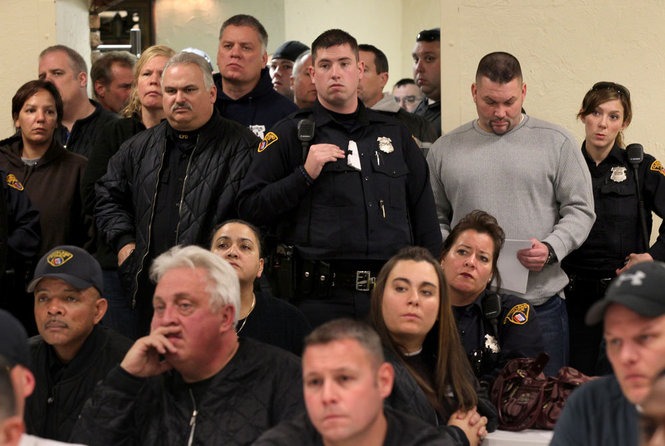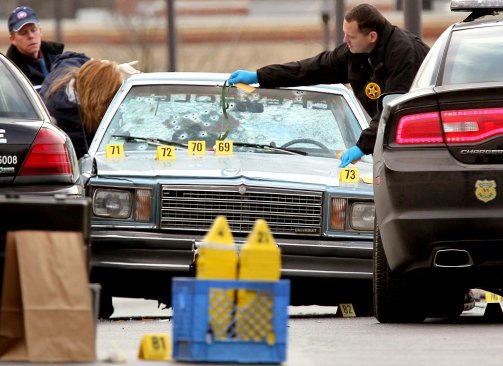In the History of Law Enforcement How Many Unarmed White People Have Been Killed by Black Cops? NONE. [White Cleveland Cops Claim they are Denied Equal Treatment Under the Law - file suit]

Anon asks: "Q: What is collective power?
A: Collective power is the institutions and systems that benefit one group at the expense of another group, and allow one group to dominate another group in all areas of human activity.
For example, when a white policeman shoots an unarmed black man (50 times), his fellow officers, the police chief, internal affairs, the union, the media, the prosecutor, the judge, and the jury will support, defend, and finance that white police officer’s “right” to shoot (murder) an unarmed black person. That is white collective power.

It is rare for a white police officer to be punished for using excessive force against a black man, woman, or child. It is just as rare for a black police officer to use excessive force against a white person.
In fact, the authors were unable to find a single instance of a black police officer shooting or killing an unarmed white person in the history of modern law enforcement. This is not surprising but it is absolute proof that the black individual operating within a system of white supremacy cannot mistreat whites even if he or she is wearing a uniform, a badge, and carrying a gun." [MORE] In photo, 137 Shots were fired at an unarmed Black couple who were executed by mostly white cleveland cops in 2012. In top photo white cops are briefed after that incident. [MORE]
From [ThinkProgress] Less than a week after twelve-year-old Tamir Rice was fatally shot by Cleveland police officers who thought Rice’s toy gun was real, nine other members of the Cleveland Police Department filed a lawsuit that accuses the department of discriminating against non-African American officers who used deadly force.
In the suit, the plantiffs claim that the department treated non-African American officers involved in the 2012 shooting of two African Americans “substantially harsher” than African American officers involved in the same incidents. The lawsuit deals with the aftermath of a deadly November 2012 car chase. During the car chase, 13 police officers fired over 130 shots at a Chevrolet Malibu. Both people in the car were shot over 20 times and killed. Neither had a weapon. During an investigation of the car chase, it came out that officers had omitted events in their statements, misidentified the suspects and did not specify that police officers had fired shots. Earlier in November, the city settled a lawsuit over the incident for $3 million.
The officers alleged that the department’s practices place “onerous burdens on non-African American officers, including the plaintiffs, because of their race,” which violates their due process and equal protection under the law. The officers argue that as a result, they have lost wages and have suffered “impairment of their professional reputations, humiliation, emotional distress, mental anguish, and other serious damages.”
The officers’ share of the punishment was 3 days of administrative leave, followed by restricted duty for a period of time — typically 45 days — during which they say they were asked to do “menial and unpleasant tasks” and denied overtime pay. The nine officers were not allowed to return to active duty for 16 months due to media and political pressure, which hurt their ability to apply for promotions and denied them “a substantial amount of income,” the suit alleges. The suit also argues that the nine officers should not have been disciplined individually because Ohio’s attorney general Mike DeWine attributed the incident to systemic failure within the entire department.
While the city is on the hook for the $3 million settlement over the incident, individual officers in Cleveland paid about 1 percent of the settlement. A study in the NYU Law Review found that it is rare that individual police officers actually pay the plaintiffs in such lawsuits. The study found that individual police officers in New York City and Los Angeles paid .03 and .008 percent of settlement money to plaintiffs respectively.
The lawsuit was filed as national police brutality protests erupt not just over a grand jury’s decision not to Ferguson officer indict Darren Wilson, but also by another fatal shooting in Cleveland’s own community. On November 23, a Cleveland police officer shot and killed Tamir Rice, a 12-year-old boy, believing that the toy gun he was carrying was real. According to Cleveland’s deputy police chief, Rice did not threaten the officers who killed him or point the toy gun in their direction. City officials said that police officers waited almost four minutes after Rice was shot to give him first aid. On the video, the gun is not visible when the cops arrive and no people are present. That is, when the cops arrive there is no ongoing emergency, imminent danger and no crime was being committed in their presence. As such, the Cops did not have a Constitutinal basis to order him to stop and to seize him the way they did.